The Dubai higher education sector is witnessing unprecedented growth. The Knowledge and Human Development Authority (KHDA) announced that enrolment surged by 20% in the 2024–25 academic year, pushing total student numbers to a record 42,026. This reflects a dramatic rise in both international and Emirati enrolments, cementing Dubai’s growing role as a global education hub.
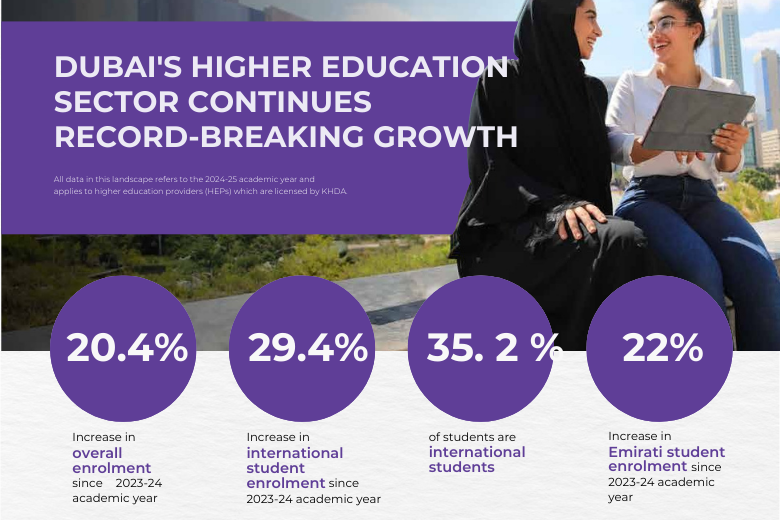
International Students Flock to Dubai Universities
In a striking trend, the number of international students grew by 29%, now accounting for 35% of total enrolment.
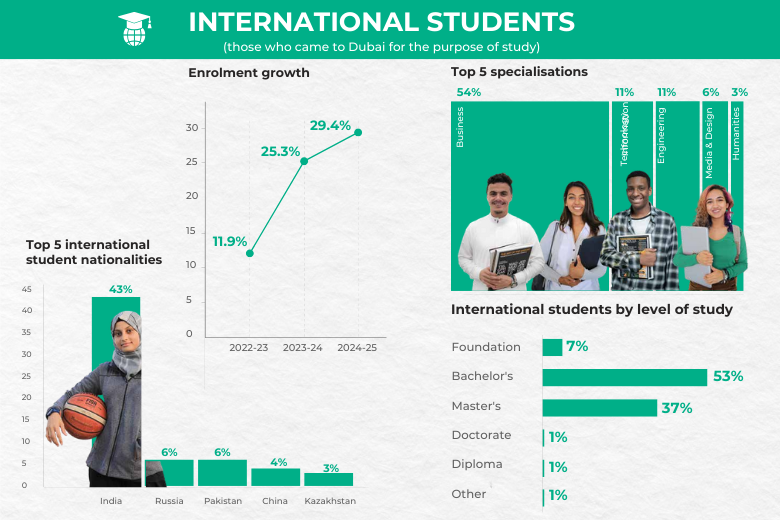
According to KHDA’s latest infographic, the most represented nationalities include India, Russia, Pakistan, China, and Kazakhstan. This surge aligns with the goals of the Education 33 strategy, which targets a tenfold increase in education tourism by 2033.
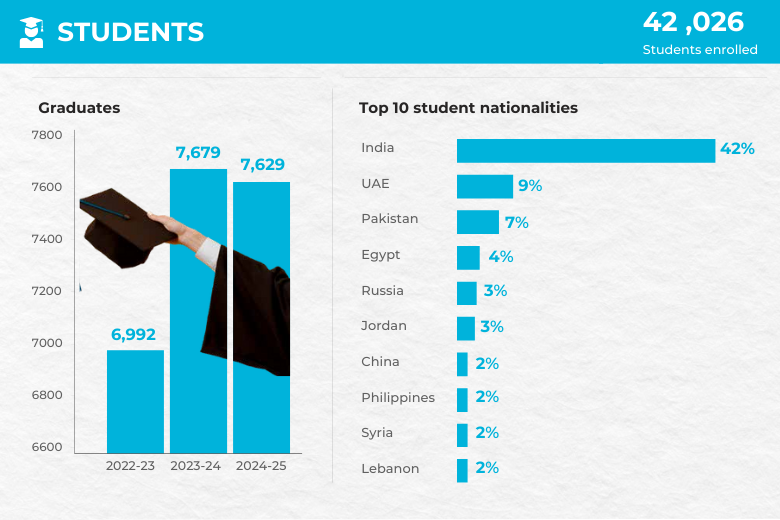
High-Demand Courses Fuel the Dubai Higher Education Boom
Much of the growth is driven by programmes in business, technology, and engineering—the top three specialisations among students. According to the KHDA, business programmes lead with 44% of total enrolment, followed by IT (15%) and engineering (13%).
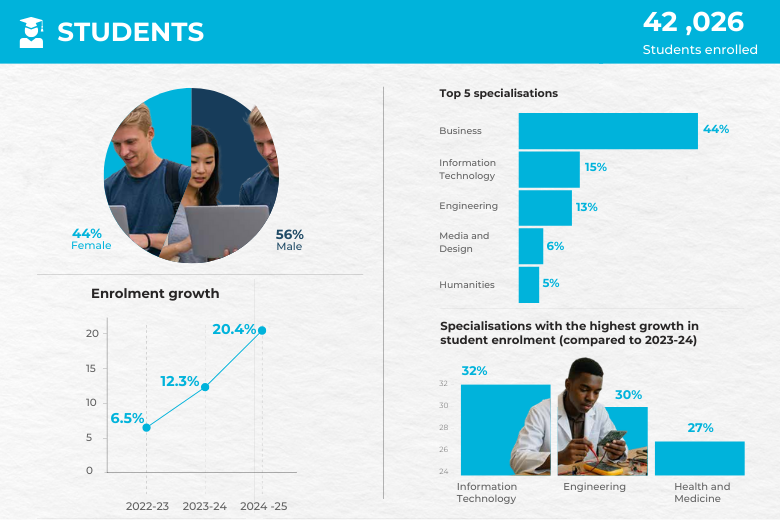
Symbiosis International University Dubai reported a 120% rise in student numbers. Speaking to Khaleej Times, Dr. Anita Patankar, Executive Director, said,
“We’ve seen a remarkable 120 per cent increase in student enrolments this year. This reflects not just growth in numbers, but in the trust placed in our globally relevant and CAA-accredited programmes.”
She added,
“Our BBA and MBA programmes are also in high demand, driven by Dubai’s dynamic economy and the strong appetite for leadership roles. We’ve introduced waitlists for some undergraduate and postgraduate programs to ensure we maintain academic integrity while meeting demand.”
Waitlists Reflect Rising Demand
Several institutions are managing the demand by implementing waitlists. At Symbiosis Dubai, B.Tech applicants must meet a minimum of 65% in Physics, Chemistry, and Math, while MBA hopefuls undergo interviews post-eligibility screening.
University of Europe for Applied Sciences Dubai (UE Dubai) also recorded a 25–30% enrolment increase. A spokesperson told Khaleej Times, “When application volumes are high, we do implement waiting lists. Seats are offered on a first-come, first-serve basis, and early applications significantly improve a student’s chances.”
“Early application is key,” advised the UE Dubai spokesperson. “Not only does it speed up admissions, but it also opens access to scholarships and reduces stress around relocation and finances.”
Alternatives to Traditional Waitlists: AGF’s Scalable Model
Meanwhile, some organisations are sidestepping waitlists entirely by taking a different approach to scaling. The Abdulla Al Ghurair Foundation (AGF), which focuses on empowering Emirati and Arab youth through education, has witnessed close to 14,000 new enrolments across its programmes between January and May 2025.
“We don’t believe in waitlists, we scale what works,” said Dr Sonia Ben Jaafar, CEO of AGF, in an interview with Khaleej Times. “Our aim is to remove barriers, not reinforce them. Whether it’s through digital literacy, cybersecurity, or gaming, our programmes meet youth where they are, and expand to meet demand.”
AGF’s Massar Al Ghurair platform, powered by AI, helps students identify personalised learning paths aligned with UAE’s job market trends. The focus, Dr Jaafar said, is less on traditional performance metrics and more on mindset and potential.
“When learning is relevant and certified, youth show up, ready to lead,” she added.
Emirati Enrolment on the Rise
Emirati enrolment grew by a record 22% in 2025, reaching 3,832 students. According to KHDA, this reflects the increasing confidence of UAE nationals in the quality and global relevance of local higher education providers.
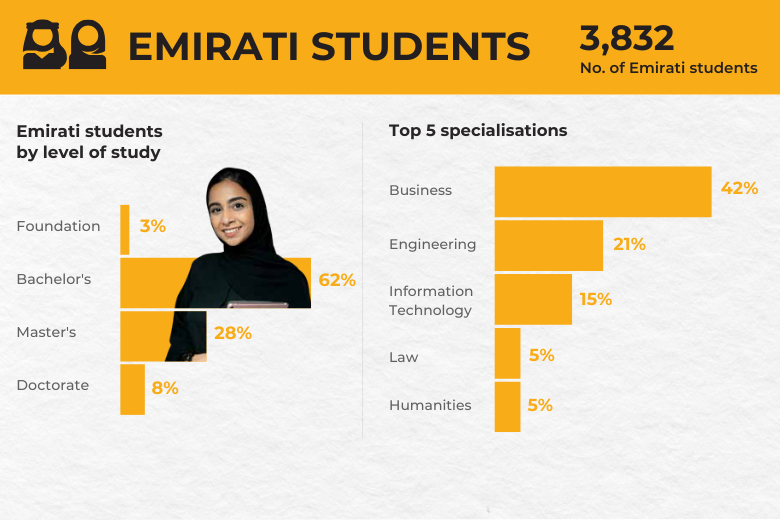
New Universities Join Dubai’s Higher Education Ecosystem
Four new international universities opened campuses in Dubai this year, hailing from China, Russia, India, and France. This expansion brings the total number of licensed higher education providers to 41, of which 37 are international branch campuses.
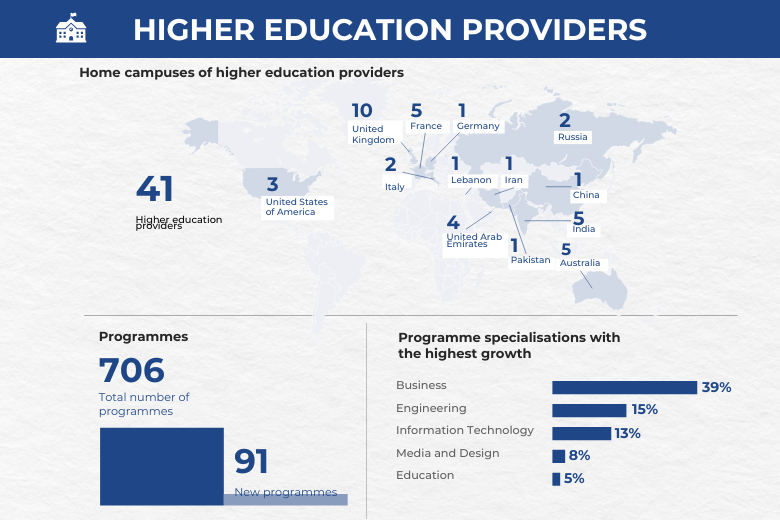
How Parents Should Approach the Decision-Making Process
With the landscape evolving rapidly, parents considering Dubai higher education for their children should:
- Apply early to maximise scholarship and admission opportunities
- Research programme specialisations and career pathways
- Attend open days and speak to admissions teams
- Explore universities with strong international links and industry alignment
Looking Ahead
With KHDA’s Education 33 strategy setting ambitious goals, including having three Dubai universities in the QS World Top 100 and 50% international enrolment, the emirate is clearly on a path to becoming a global higher education destination.
Further Reading:
- Sheikh Mohammed Announces AI as Mandatory Subject in UAE Schools
- Insider’s Guide to the UAE Education Boom: 10 New Schools Opening in Dubai and Abu Dhabi for 2025–2026
- The Park That Will Change Everything: How Disneyland Abu Dhabi Signals a New Era for the Middle East








